Giving $3000
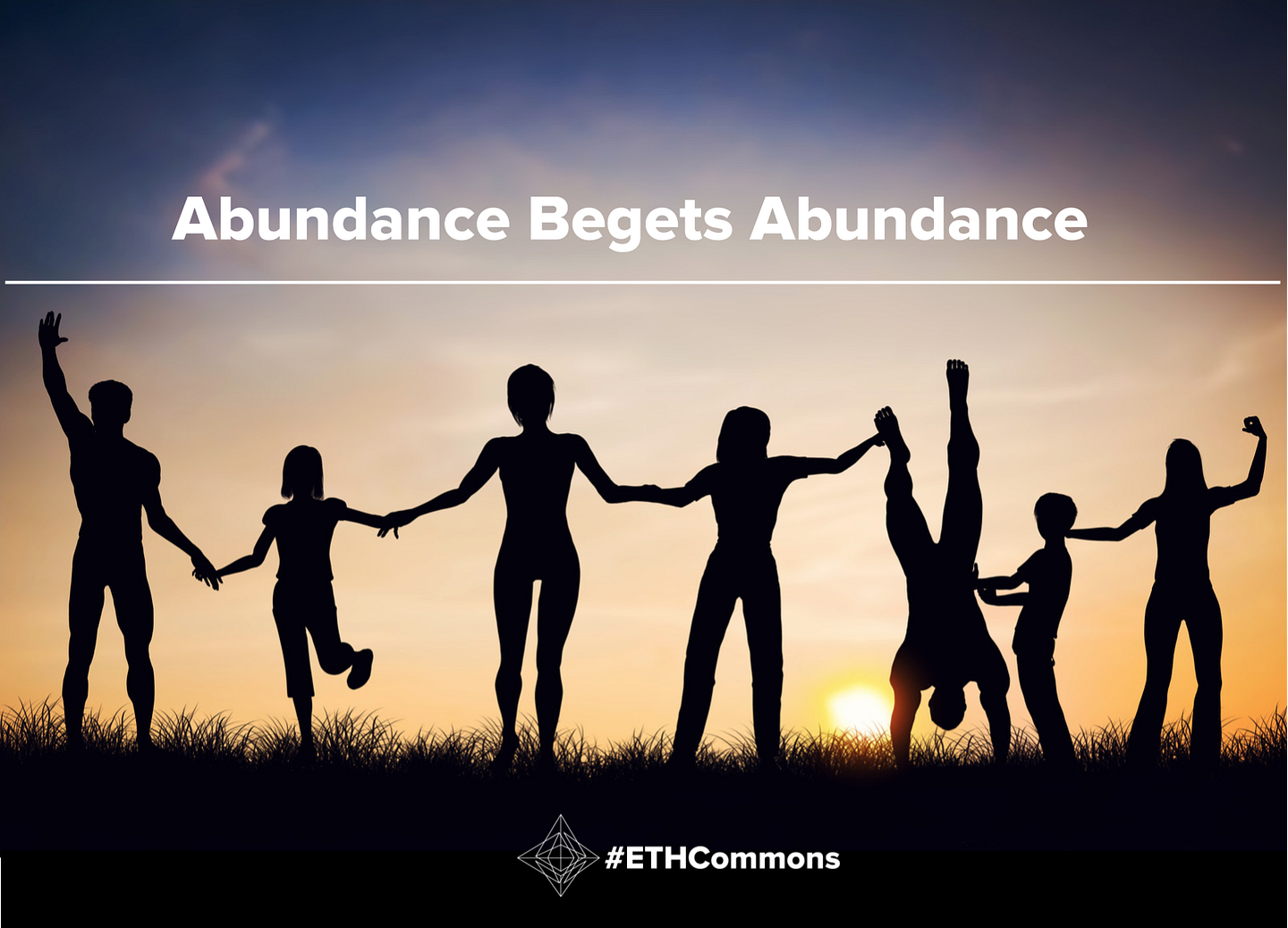
I just donated $3000 to 6 causes (yay!). The goal of this article is to explain both: 1) Why I donated and 2) How I chose the 6 causes. The highlights are:
- I became carbon neutral for the last 4 years of my life! (For $50)
- I supported a year’s worth of basic income for someone in Kenya! (For $360)
- I gave $1200 (matched $1200 by Niel de le Rouviere!) to support a $2400 grant to fund a Co-Steward of ETHCommons.
- I show you how much money I have! (In my Wells Fargo account and crypto wallets.) Don’t steal from me plz :)
This is all to say: I’m excited to donate $3000 today (which is about 15% of my net worth). In the big picture, it’s not much. But if we virally spread this donation mindset (the #CryptoPledge), then I think we’ll be much closer to resilience in the face of massive converging exponential change. If you’re interested, read on!
Why Should One Donate?
Macro Context
There are two crucial aspects to our current era and why our global society needs to (and can!) undergo a phase shift (from #LateStageCapitalism to what we call “GameB”):
- Humanity is in a fragile position because we are about to experience massive converging exponential technological change.
- At a macro and micro level, we’re transitioning to abundance. We’re close to having “enough”—where money doesn’t equal more happiness.
The first point (fragility) says that it’s necessary to phase shift. The second point (enough) says that we have sufficient conditions to phase shift. It’s perfect—necessary and sufficient—hooray! Let’s look at each:
Speed → Fragility → Necessity (to Shift to GameB)
In the last 25 years, the number of people connected to the internet has gone from ~0B to 4B (source). That’s a big change. The marginal cost of information propagation is 0. That means that we’re able to learn, create, and distribute value much more quickly and efficiently. Which is good! Here’s Naval Ravikant noting this as a 100,000x increase in leverage from 1999–2014:
Here’s a visualization of this “Value Loop Speed” (how fast value moves in a system). Roughly speaking, here’s what it like in the 90s (Web 0.0) before Mosaic and Netscape and AOL. (By the way, you don’t really need to understand this gif deeply. Instead just “grok” the feeling of this 1st gif, and compare it to the feeling of 2nd gif below.)
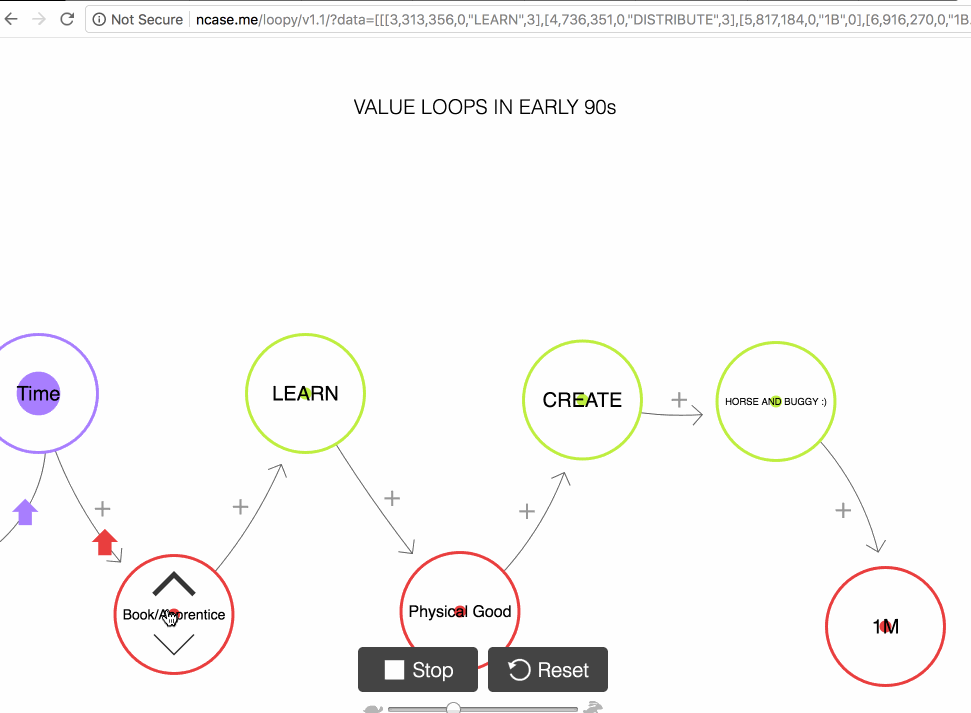
And here’s what things look like in 2018 (Web 2.0) after Google and Amazon and Facebook and Apple.
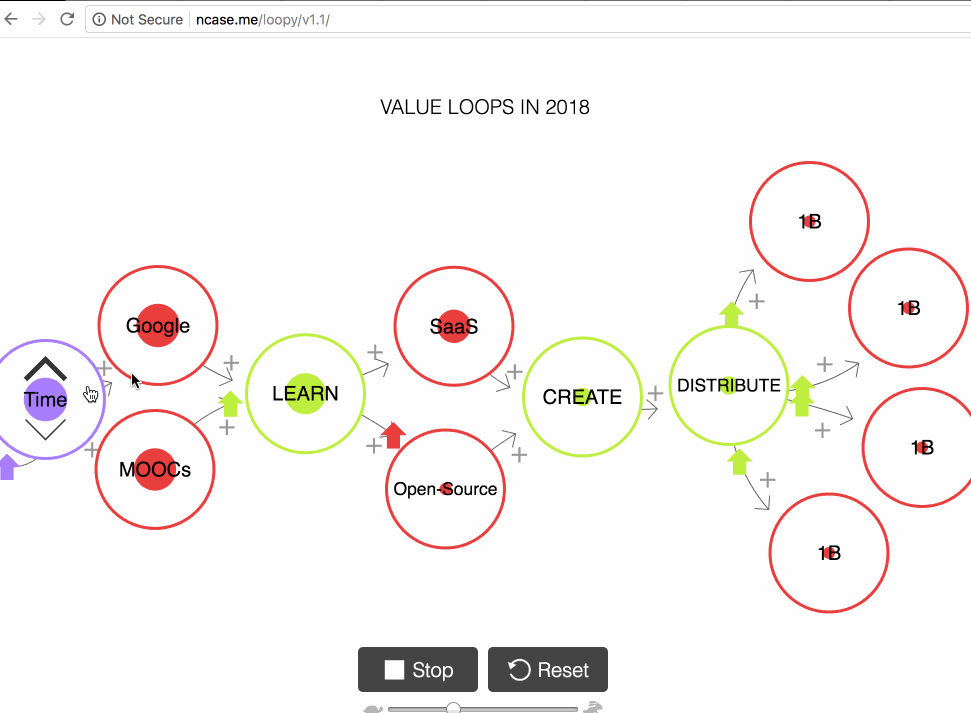
All that value creation would be awesome except technological progress is incentivized (through capitalism) to ignore externalities. In other words:
If the Industrial Revolution created climate change as an ignored externality, then the Digital Revolution (CRISPR, AI, VR/AR, Blockchain, etc.) is going to create self-extinction as an ignored externality.
So that’s why it’s necessary to phase shift to GameB. i.e. With great power comes great responsibility. Luckily we also have the ability to catalyze this phase shift:
Compounding Technology → Abundance → Ability! (to Shift to GameB)
We have two really great things going for us:
- Power: All of that technology that could kill us can also help us.
- Abundance: Many of us in developed countries have “enough” to be happy, and can “give back” to support this phase shift.
Let’s stay on that second point—abundance. Right now many of us have morethan enough wealth to be happy and so we can actively give back. This is a crazy idea, especially because it wasn’t true for the last 100,000 years—it only became true in the last 25 or so. In fact, there’s been a massive change in the last 200 years. 200 years ago:
- 94% of people lived in extreme poverty
- 83% did not have a basic education
- 88% were not able to read
- 99% did not live in a democracy
- 100% were not vaccinated
- 43% of kids died before they were 5.
Now, all of those numbers are reversed. Things are much much better. (See a graphical representation below.)
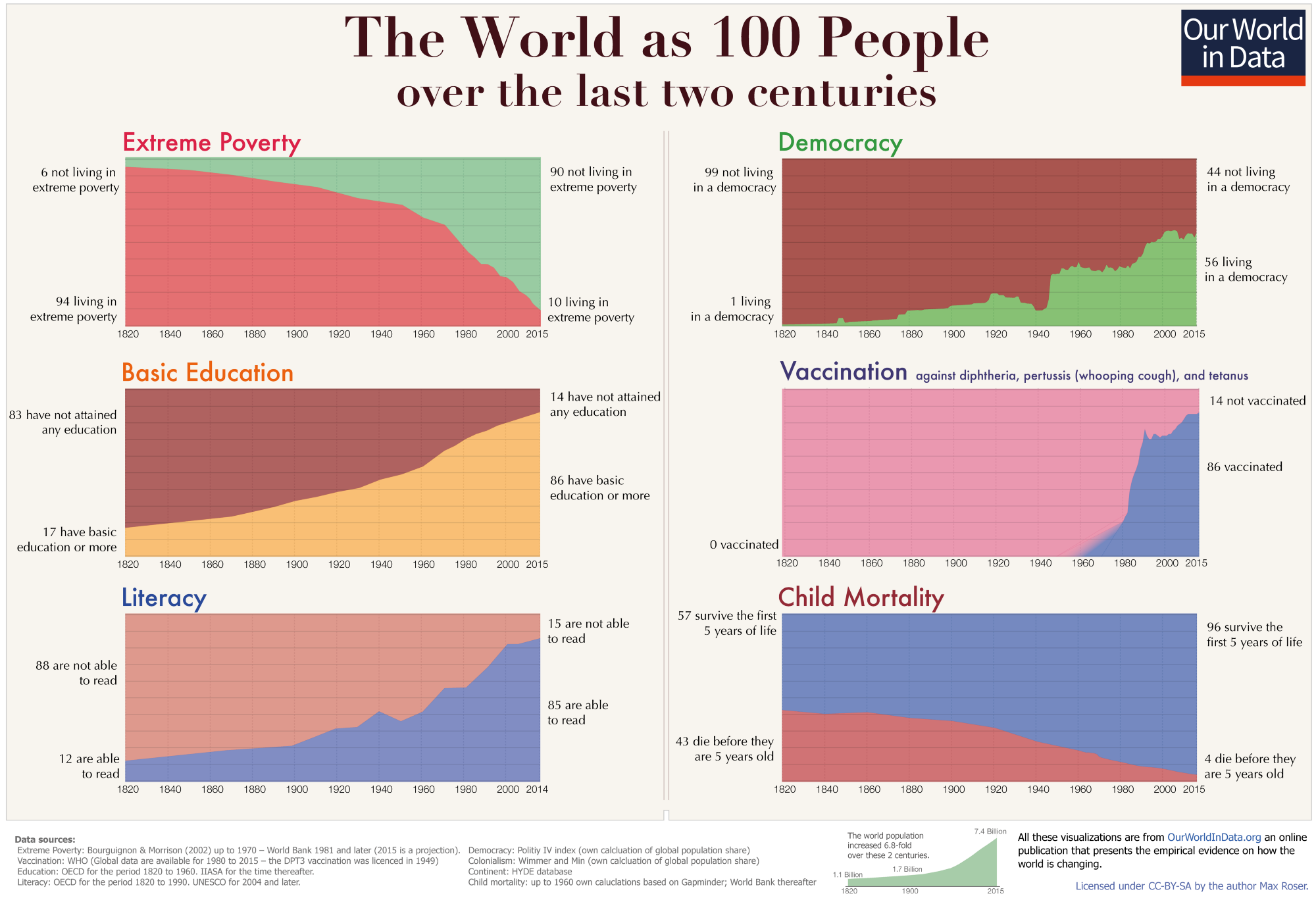
And this isn’t only true at a societal level. It’s also true on an individual level. 50,000 years ago (or even 200 years ago) it made sense to accumulate wealth because more wealth meant better medicine, healthier food, a bit of leisure time, etc. But now? More wealth doesn’t make us happier. We’ve essentially hit the limit (or are experiencing vastly diminished returns). After ~$48,000/year, you stop getting happier when you get more money.Here’s a graph of money vs. four different measures of happiness (note the log x-axis). We can see happiness stop increasing at just around $48,000/year.
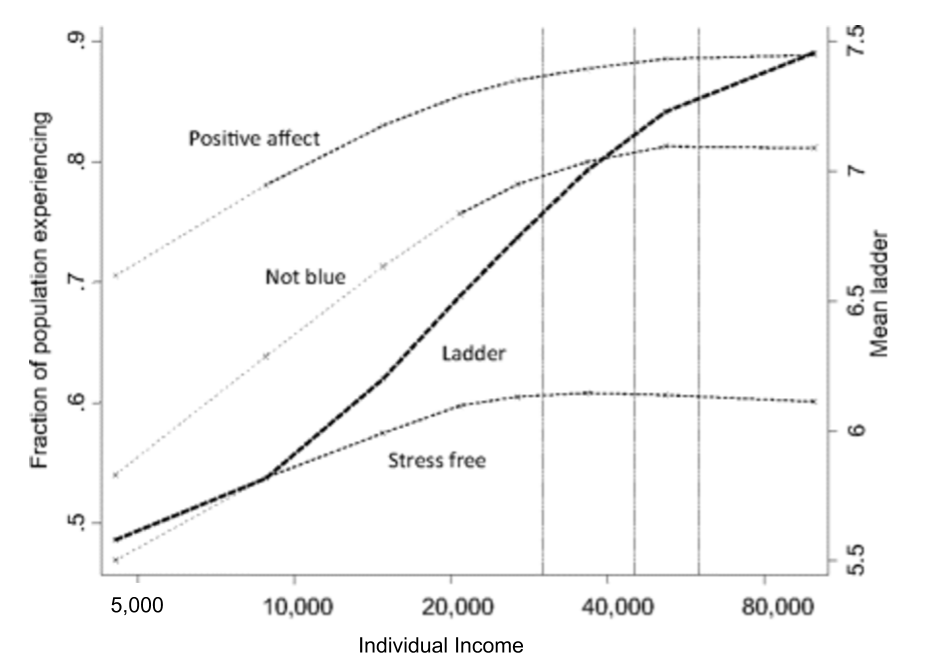
And, here’s the bonus upside: not only does giving after $4,000/month notdecrease our happiness, it actually increases it. This is for two reasons:
First, by giving to those poorer than us, we move them up the economic ladder, making them (and their needs) more “similar” to ours, which both increases the demand for things we want and the supply of those able to produce those wants. This is a bit of strange concept, but is crucial to a win-win abundant future. Essentially, imagine something that you want, like a cure for Alzheimer’s disease (my mom has this disease). If we want that to happen, then we want both:
- More people to want this too (increased demand). If poor folks were surviving longer (through global health programs like malaria bed nets), then they would start to experience Alzheimer’s more (because they’re living longer). This would mean that they would start demandingAlzheimer’s cures, research, etc. In addition to the demand, we also want:
- More people that can produce to meet that demand (increased supply). e.g. If more poor folks had a better education and were able to break the scarcity mindset to think long-term, then they could start contributing to Alzheimer’s research and help develop those cures.
So, giving to poor people would make me happier because it helps poor folks be more like me, increasing the supply and demand for things I want. As Kurzgesagt said in their recent video: “This is what it means to live in a positive sum world. The more people that want the same thing you want, the more likely you are to get it.” (I highly recommend watching their 7min video that explains this concept—A Selfish Argument for Making the World a Better Place — Egoistic Altruism.)
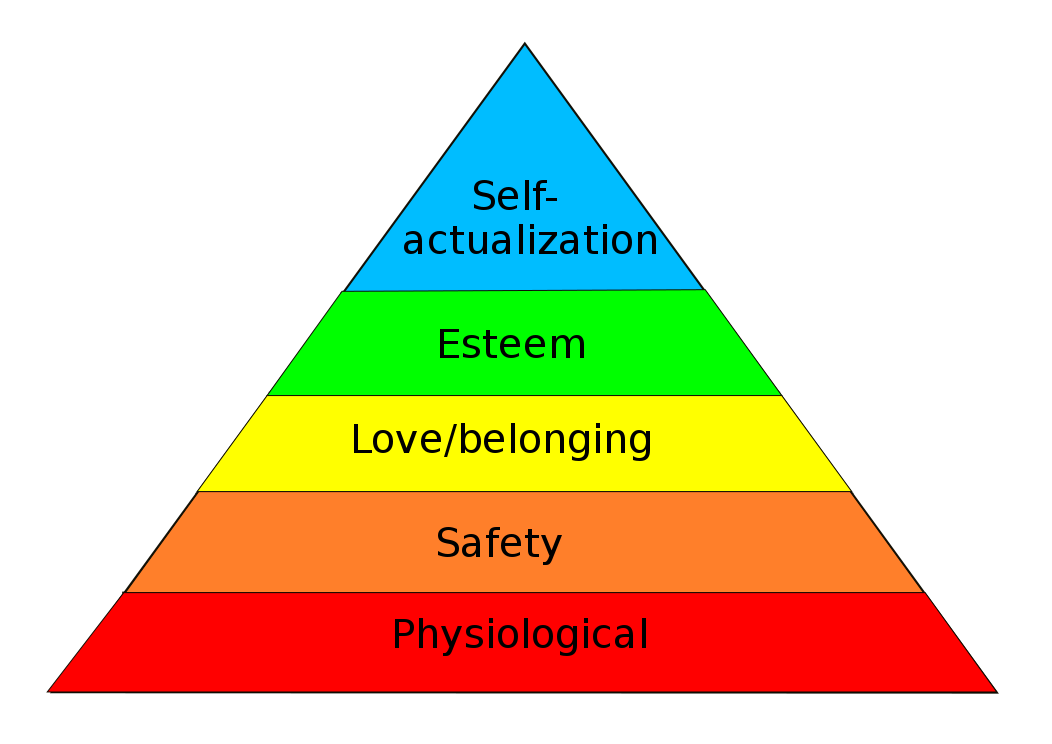
In addition to the increase in happiness from moving supply/demand curves, giving also increases our happiness because it helps us move up Maslow’s Hierarchy of Needs. Once you’re making $4,000/month, you can meet your basic physical and safety needs (the first 2 levels). After that point, I highly recommend something like personal therapy to focus on the next two layers: love/belonging (meaningful human connection) and self-esteem (understanding of yourself, your fears, your insecurities). But once you feel satisfied with those things, what’s next? Where do you derive meaning if all of your needs are met? By self-actualizing of course! As Maslow himself says “quite often, when a person is at the level of self-actualization, much of what they accomplish in general may benefit others, or ‘the greater good.’” i.e. There’s no better way to self-actualize than helping others move up Maslow’s hierarchy, self-actualizing humanity as a whole (and dodging global self-termination!).
(Note: if you’d like more “macro context” before moving on, check out my article here.)
So What’s Holding Us Back from Giving?
If we don’t get happier after $48,000/year (about $4,000/month), then why are there so many people I know (devs, crypto whales, etc.) who have much more wealth than that, but don’t give back? If more money doesn’t matter, why isn’t everyone giving it back? As far as I can tell, there are two issues: mindset (inertia) and power.
On Mindset, Inertia, and Fear: We’ve been told (by pretty much everyone) that intelligent long-term thinkers save their money. It’s a best practice to save for retirement, have a rainy day fund, save for your kid’s college, etc. But, put another way, saving is accumulation and accumulation the root of scarcity and win-lose game dynamics. Saving is good (and increases your happiness)…up to a point. But hoarding is bad. So maybe we shouldn’t save for retirement? (You can see me realize that here.) In addition to social pressure, this inertia to hoard is deeply rooted in fear. What happens if I give too much and then end up on the street? What happens if my house floods? This fear is true to some extent (i.e. don’t give away all your money). But it’s also worth experimenting with your fear. Lean into it. Personally, I’ve found a vibrant web-of-trust (created by the people around me) acts as a safety net to help me face this fear.
On Power: The other crucial issue here is that more money does equal more power. Put another way, money doesn’t have nearly the diminishing returns on power (as it has on happiness). e.g. Bill Gates has at least 100,000x my power/influence/leverage, but I’d be super surprised if he had even 10x my happiness (I’m pretty happy :). Power is one I’m personally wrestling with a lot. Do I want an executive assistant? Yes. Do I want to travel to top conferences? Yes. Do I want to have capital flowing to my ideas? Yes. But, if I’m trying to help the phase shift to GameB, should I? (e.g. If a $1000 conference flight equals a year of basic income for three people, it better be a great conference.)
There’s even a selfish way to look at this. We’re beginning to see the power of money decrease (as capital becomes abundant). These days, attention (and associated reputation) are becoming more powerful. e.g. Would you rather have $1,000,000 or 1,000,000 Twitter followers? In 25 years, who will have more social capital: a super rich person who takes their friends out to classy dinners OR a “do gooder” who has actively been working altruistically for the future of humanity? The way we signal status will be much different in GameB. Even today, I personally place much higher status on those who live modestly, rather than those who treat me with nice food, wine, clothes, etc.
To conclude, I hope the above sections give you a good idea for why:
- Giving doesn’t decrease happiness.
- In fact, it might increase it.
- But there’s lots of inertia keeping us from giving.
Whether you’re actually convinced or not (and whether or not you give) the above gives me enough reason to give. So let’s talk about that!
How Much Am I Donating?
So a bit of background. I’m not a “crypto whale”. i.e. I don’t have crypto just lying around from 2015. In fact, I haven’t ever actually purchased more than $100 of crypto. (I could’ve purchased ETH at $50 when I got into crypto last April. You could “correctly” argue that it was stupid of me not to. You could also argue that I don’t have enough “skin in the game”. But I really wanted to aggressively counter signal against much of crypto that was in it just to “make money”.)
Anywho, I ain’t rich. Here’s how much money I’ve made over the last 4 months.
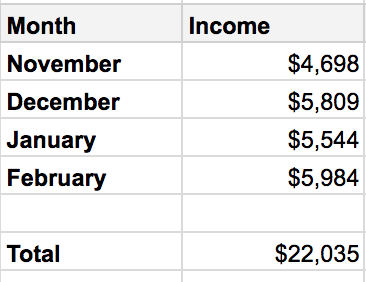
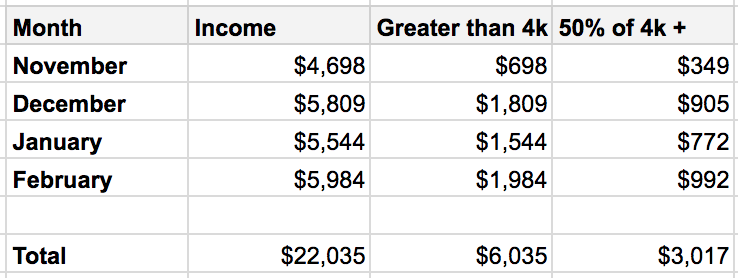
So, I should give about $3,000 back, hooray! (Note that I’m applying the monthly version rather than the yearly version. i.e. I’m giving monthly as it comes in, rather than waiting until after I’ve passed $48,000/year to give.)
It’s kind of funny to be excited to give only $3,000. Like, OMG, Rhys gave $3,000. That’s both: a) Nothing in the big scheme of things and b) A lot less than lots of folks give (e.g. $86M of Bitcoin from PineappleFund, $2.4M and 750k from Vitalik). But still, it feels good, especially given my own means and also given that this is a proto-example of “playing an infinite game” (i.e. a system in which everyone self-taxes themselves to give back, therefore creating a happier and more antifragile system, which is more likely to create an “infinite game” where humanity doesn’t self-terminate).
In any case, I also think it’s worth looking at how much I have accumulated myself (i.e. how much is in my bank account and various crypto wallets). It’s important to think about both flows (monthly salary) and stocks (total accumulated). Because I’m essentially “starting from $0” (I almost ran out of money in November), I haven’t accumulated much — about $18,500 total. Here is my Wells Fargo account and Metamask. (I don’t have any crypto in Coinbase or in a hardware wallet.) Also note that this picture was taken before I gave my $3000.

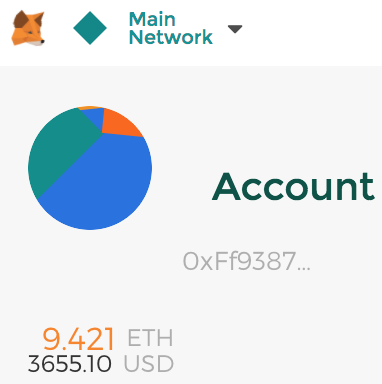
Note: This may be REALLY dumb to be transparent about how much money I have. Essentially everyone else in the crypto (and non-crypto) space actively hides how much money they have. Privacy is the status quo. I’m striving for radical self-imposed transparency — really being honest about how much we have and how much we need. Since I know there’s going to be some push back against this, let’s take a little tangent to talk about wealth, stealing, and how we should think about thieves.
First, note that its “easier” for me to be transparent about my wealth because I don’t have much. It’s more difficult for a crypto millionaire to say: “Look at how much money I have!” because that would invite others to hack their account or blackmail them. In fact, in August of last year, someone hacked my phone, email, and Coinbase to try to steal my money. They targeted me because they assumed that, as an active person on crypto Twitter, I would have money. Haha, little did they know, I had none! (Or very little.) Here’s an email they sent me (from my own email address) after they got into my Coinbase and didn’t find much money:
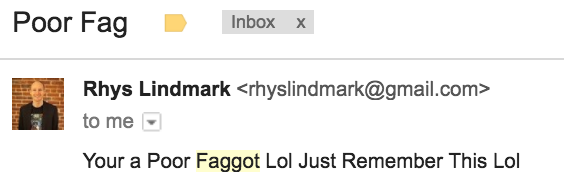
Also, the traditional response when someone steals from you is anger, vengeance, and demonization of the thief. Though I definitely feel that natural response too, I think it’s also quite important to think about the system-level response: What is their situation? Their context? Their childhood? What made them want to steal? What made them think it was ok to steal? In other words, think like Tara Brach:
❤️❤️❤️ pic.twitter.com/4jUOQ2uohH
— Rhys Lindmark (@RhysLindmark) February 26, 2018
This is all to say: Privacy vs. transparency is a dialectic, not a binary. I feel good experimenting with radical self-imposed transparency.
What Am I Donating To?
So we’ve looked at both why one should donate and how much I’m donating. Now let’s talk about the buckets (i.e. “causes”) that I’m donating to. They are:
- Internalizing My Own Externalities: $50
- Effective Altruism: $750
- Macro Systems Change (to GameB): $250
- Hyper Local Abundance as Emergent Community Government: $250
- Identity, Diversity, and Inclusion: $250
- Scaling ETHCommons: $1500
- Total: $3050
#1—Internalizing My Own Externalities: $50
So a crucial part of this “transition to GameB” is the idea that we begin to internalize externalities. In general, “internalizing externalities” means that you take a “full system” view and look at how any action affects each agent in the system (i.e. an “omni-considerate” perspective). The goal is to create a circular, regenerative, resilient system (rather than an exponentially fragile one, purely optimized for growth).
Right now, I’m just going to begin to internalize my externalities w.r.t. climate change (i.e. how my lifestyle contributes to greenhouse gases that are warming the planet and will contribute to refugee crises, food crises, etc.). I want to be a carbon-neutral individual. Although there are other externalities that I could internalize, I think this is the clearest and highest impact. What I’m going to do is: determine how much carbon I output into the atmosphere and then offset that by essentially “planting trees”. I could also internalize my externalities by changing my behavior: biking more, eating less meat, etc. (and I do most of that, but today we’ll focus on “paying for my sins”).
So how much carbon am I outputting into the atmosphere? It’s pretty close to 10 tonnes/year. There’s a couple ways to determine this:
- Use CarboTax.org. This is a very smooth site that asks you 30 quick questions and determines how much you should offset.
- Just start at 5 tonnes and add 1 for each round-trip flight you took last year. This is honestly the one I’d most recommend. Long-distance travel (often flights) are most of your carbon footprint (source). Did you take 20 round-trip flights last year? Then your carbon footprint is likely around 25 metric tons. (20+5)
- For people who are especially into crypto, I recommend offsetting your crypto transactions as well. One outputs about .05 tonnes of CO2e per transaction (source). I looked at my StakeTree account on Etherscan and saw that I had about 30 transactions. So 30*.05=1.5 tonnes of CO2e total. (Note that the number of transactions is likely to be especially high for traders or coders.)
Anywho, however you get to the answer, my answer was 10 tonnes!
One final fun note: I’ve been a vegetarian for 10 years. I did it to decrease my climate footprint. But it doesn’t really have much of an effect. It’s about 1 tonne of CO2e/year—so just one flight! (Source)
Who Should I Pay To Offset?
You should almost certainly use CoolEarth. It’s 10-25X more effective than the next best carbon offset provider. CoolEarth achieves this not by planting new trees, but by working with local communities in rainforests to use their land more productively (so they don’t sell it to logging companies). Most carbon offset providers cost about $10/tonne, but CoolEarth costs $1.34/tonne (and only $0.38 if you count the indirectly shielded forests!). Source
So I’m going to pay 10*$1.34 = $13.40 to CoolEarth to offset my carbon footprint for 2017. And, while I’m at it, I’ll increase it to $50 to offset 2014, 2015, 2016, and 2017. I’m getting closer to being carbon neutral!
Some additional thoughts:
- In addition to carbon-neutral individuals, wouldn’t it be cool if we had carbon-neutral conferences (offset the flights!), carbon-neutral companies (like Stripe!), or entire carbon-neutral blockchains? (Which would cost only $15m/year for ETH.)
- It’d be cool if “paying for your sins” could be opted into automatically (with high impact actions like planes and crypto especially). There’s a small team creating a widget to do the crypto offsets automatically (in something like Metamask). Reach out to Victor at Carbon Crypto Pledge (info@cryptopledge.co) if you’re interested in learning more!
- Remember to go for power law returns and don’t think too hard about “all the little things”. Carbon offset your flights (likely 50%+ of your footprint) and pay CoolEarth (10x more effective).
#2—Effective Altruism: $750
“Effective Altruism” is not just two words combined together. It’s a movement build around answering one simple question: “How can we use our resources to help others the most?” This has three main components:
- Choose the most effective cause. e.g. Giving money to help snake people get more avocado toast is likely less effective (i.e. will increase happiness less per dollar) than giving to a poor person in a developing country. See this article on cause selection for more.
- Choose the most effective charities for that cause. Once you’ve chosen a good cause (like donating to the poor or fighting climate change), you should give to an organization that actually uses its money well. This doesn’t necessarily mean “low admin costs”. Instead, it means $/impact. CoolEarth is a great example. Often, the most effective charities will have 10–100x the impact of the less effective ones.
- Give more. In many ways, that’s what this article is all about. Giving more (because it doesn’t decrease but actually increases your happiness!).
Within the philosophically consequentialist (i.e. impact/outcome-based) umbrella of Effective Altruism, there are lots of different ways to give your money, depending on how you weight different parts of the equation. (This is the 1st point from above, “cause selection.”) If you put a lot of weight on individual animal suffering (even just saying their pain is “worth” 1/1000th of individual human suffering), then giving to stop factory farming is high-impact (there are tens of billions of animals inhumanely killed every year). Or perhaps you put lots of weight on the long-term future (i.e. if we go extinct in the next 100 years, then that prevented millions of generations of people that didn’t get to live happy, fulfilling lives). If so, you might want to give to a cause that’s connected to extinction risk, like AI alignment, nuclear security, biosecurity, or climate change. Maybe you put lots of weight on the billion poor people living unhappy, unhealthy, and short lives today. Then you could give to health or smoking in the developing world. Or perhaps you want to “get meta” to spread this mindset and help us determine our priorities. Then you might want to give to “promoting effective altruism”, global priorities research, or improving institutional decision-making. Whatever you do, it’s likely that giving to a recommended charity for a cause on that list will be 10–1000x the impact of giving your money elsewhere. So where did I choose to give?
First, I decided to donate $360 to provide one very poor person a basic income as part of GiveDirectly’s 26,000 person UBI study. GiveDirectly is a charity that gives unconditional cash transfers to very poor people in Kenya and Uganda. They are currently running a very large randomized control trial(RCT) to see how a basic income effects people’s lives (over the course of 2–10 years). With this donation, I’m supporting 1 year of basic income at about $30/month (which includes the overhead of running an RCT), which is about 50x more effective than giving someone in America a basic income (about $1500/month).
GiveDirectly falls under the “health in poor countries” cause and is one of GiveWell’s recommended charities (GiveWell is a meta-charity that determines the most effective charities). However, GiveDirectly is about 5x less cost-effective than giving to GiveWell’s other recommended charities (which do things like prevent malaria with bed nets). I chose to give to GiveDirectly because it:
- Aligns super well with the peer-to-peer world of crypto. I’m essentially just transferring a very poor person money to increase their happiness and ability to do long-term thinking.
- Aligns well with the macro transition to abundance of capital and the creation of a UBI. (I have enough money, so I’ll give someone else that money!)
- Is really simple to understand. (We don’t need to understand malaria, deworming, etc. to intuitively understand this.)
In addition to GiveDirectly, I’m giving $390 to a meta-site called Effective Altruism Funds. It allows me to say “look, I’m not sure what’s best, but I’ll let an expert researcher who spends 1000s of hours a year on this choose for me!” Laziness ftw. You get to choose to allocate your funds between Global Development, Animal Welfare, the Long-Term Future, and the Effective Altruism Community. I’ve already given to Global Development (through GiveDirectly), and I’m more concerned about big picture with humans (instead of Animal Welfare), so I’m just going to divide it 50/50 into the Long-Term Future and the Effective Altruism Community.
#3—Macro Systems Change (to GameB): $250
Although I’m definitely an Effective Altruist fan boy, I do think they miss some high impact work, namely that of macro systems change. Essentially, the idea is that instead of solving a specific problem (like climate change), you solve the thing that created that problem (the “generative function” or “root cause”). In the case of climate change, the root cause is the “Tragedy of the Commons”. Or in the case of nuclear security, the root cause is an “Arms Race”. Both the Tragedy of the Commons and Arms Races are specific examples of sad “game theory” that hurts humans. So, if we “break” game theory, then we might be able to break all Tragedy of the Commons, Arms Races, etc. and then solve the “generative function” of many of our top problems. In the image below, you can see the causes from the list above, bucketed by their “meta-problem”, with all the game theory ones on the left:

In general, I’d call this cause the “Phase Shift to GameB”. So who is working on this? And how effective are they? Right now, it’s not that clear. I’ve chosen to divide my money in two chunks:
First, I donated $125 to Pachamama Alliance. This is because the founder, Lynne Twist, seems to be scaling a nuanced understanding of systems change (through workshops). There are two key components to systems change:
- Changing people’s mindset (what Marx calls “superstructure”)
- Changing the underlying infrastructure (what Marx calls “base”)
These two elements reinforce each other, so they need to be changed in parallel. Pachamama Alliance is changing people’s mindset through their Awakening the Dreamer course and they are changing the infrastructure through their Game Changer Intensive. In 2016, about 5000 people took one of these courses. Pachamama seems to be one of the only groups giving workshops on the phase shift to GameB, and I’m happy to support them to do so. (They’re saving me the effort ;)
Second, I donated $125 to The Starhouse, a community gathering place near Boulder, CO. If it was just a “normal” events place (to hold weddings or whatever), I wouldn’t donate. But, from my experience at Starhouse, they seem to be creating a “strange attractor” for GameB. Though “strange attractor” has a slightly different definition in the mathematical field of dynamic systems, I like to define it in the non-mathematical realm like a virus: “a state that is ‘better’ than the status quo, attracts people to it, and virally propagates”. One could say the the internet was a strange attractor w.r.t. information, or that crypto is becoming a strange attractor w.r.t. value. Starhouse is a geo-based strange attractor w.r.t. meaning.
Our hopeful GameB reality will involve lots of hyper local places (like Starhouse) that are able to survive in GameA (even though they’re playing GameB) and even “beat” GameA by showing the possible awesome future of GameB, therefore bringing more folks over to the GameB mindset. Starhouse does this with workshops that catalyze self-change (similar to the Awaken the Dreamer course from Pachamama) and by holding long-term space for the kind of deep, authentic, vulnerable work that builds strong connections that we’ll (likely) need in the face of the upcoming fragility. Imagine them like a consistent/long-term Burning Man that is optimized for altruism, not expression. (But both give “blank slate” vibes to show what is possible. To build backwards from the future rather than forwards from the status quo.)
#4—Hyper Local Abundance as Emergent Community Government: $250
Closely related to Starhouse is the idea of “hyper local abundance as emergent community government”. I’m not sure the best way to explain this, but here’s a story to explain my train of thought.
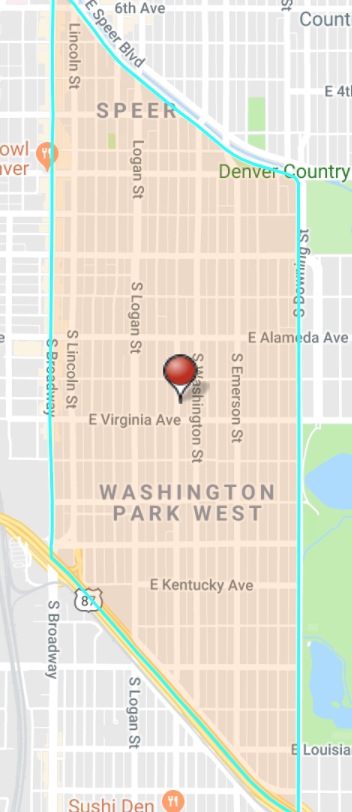
I thought I would have much more influence over my local government than the national or international government. Unfortunately, when I looked into joining my local neighborhood association (here), I was pretty disappointed. First, the neighborhood association didn’t feel that local at all. It covered almost 180 blocks (see the image on the left), with likely over 5000 people! Second, of those 5000 people, only about 50 showed up to the annual meeting, and most of them were NIMBY-ists, who were scared of density and change.
I thought: “Should this 5000-person neighborhood association really be the smallest operating unit of our society?” That may have made sense when transaction costs were higher, but now the marginal cost of moving information and value is zero, so we should be able to make smaller operating units. 150 people perhaps? A couple blocks? Also, should fear be the primary vibe in the room? Shouldn’t it be abundance? I felt a desire to create new bottom-up systems of community (which then begin to overlap with government!) that are based in abundance and more directly co-evolve with technology (i.e. neighborhood Slack groups!).
To push this idea of hyper local abundance as emergent community government, I’m donating $250 to my old 6-person co-op house (that I just left to become a crypto digital nomad). Hopefully this will help them with some coordination problems that are based in the “house commons” (i.e. instead of requesting funds to pay for garden supplies, there will be a fund for the “house commons” that can be pulled from). Also, I hope some of the funds help them integrate more with their surrounding community. e.g. There’s a 10-year waitlist on our community garden, so they are planning to turn their front yard into a garden with food like cherry tomatoes that the community can eat.
One final note: you can also imagine this as me “paying off my shadow”. I’m mostly “ignoring” the hyper local community stuff because I’ll be traveling a bunch (generally operating with a global mindset). But I still think consistent local community is super important to our future, so I can “pay” to make it happen (even if I don’t do it myself).
#5—Identity, Diversity, and Inclusion: $250
Speaking of shadows, I’ve got another pretty big one: I’m a white, straight, upper class male from America! Talk about a good lottery ticket. This means that I have essentially NO experience with all the challenges of historically disadvantaged folks. From Day 1, the world has told me: you’re smart, you deserve power, and we accept you. It’s been “nice”, but I’d also love others to have this experience. There’s all kinds of reasons to argue for more kinds of people to have more power, the strongest of which is: we need diverse intelligences to build an antifragile world. A bunch of Rhys-like people sure won’t get us all the way there.
So, given that, I’m going to donate $250 to AllRaise.org. They’ve been pushing out a ridiculous amount of high-quality initiatives to increase female inclusion in tech/venture capital.
A note on identity: this ecosystem is clearly ripe with opportunity for dialectic instead of debate. We’re seeing an intense polarization between SJWs on the left and r/The_Donald on the right. However, both Jordan Peterson and AllRaise are being relatively reasonable and there’s a great opportunity for synthesis. (Also, note that I’m giving to AllRaise, not Jordan. :)
#6—Scaling ETHCommons: $1500
For my final (and largest) bucket, I’m going to be “selfish” and give to the ETHCommons (something I started). This is broken into two buckets:
- ETHCommons Community Contributor Awards. $300 of retrospective “support” for people that already provided lots of value (but haven’t been compensated).
- ETHCommons Co-Steward Grant. A $1200 future-facing “grant” to “hire” another co-steward of the ETHCommons.
ETHCommons Community Contributor Awards ($100 to 3 People):Looking at the past ~6 months, there were lots of people who provided lots of value for the commons without asking anything in return. However, for me, three stood out.
Griff Green: For his work on the ScalingNow! video series, the ScalingNow! conference, and the Open-Source Block Explorer.
Robbie Bent: For his work interviewing many ETH developers to kickstart ETHPrize and for his work in creating a community builders “guild” (called Community of Communities) that helps crypto community builders collaborate on shared challenges.
Linda Xie: For her work on learning and aggregation. Doing Crypto Office Hours—1:1 calls with women curious about crypto, her Beginner’s guide series on cryptoassets, and for aggregating tips for crypto newcomers.
Thank you to Griff, Robbie, and Linda! There are a couple funny things about giving them money:
- They don’t need it. In theory, if I’m donating, shouldn’t I be giving to people “in need”?
- But, I feel like these folks have provided immense value to the ecosystem and really are living the #ETHCommons mindset. So given that they provided value, I think they should be compensated.
- This is a “flip” of the traditional value for value exchange (where one pays for something before they get it). In this, I’m paying afterwards and I’m opting in to paying them.
- Also, there’s a strange circular thing here with Griff. He was one of the initial supporters of ETHCommons on StakeTree. So, by getting money back, he kind of “made” money from his initial support (though he made less than he gave). How does this relate to our traditional idea of “profit”?
- I’m not sure exactly what will come of this, but there’s some kind of interesting emergent property when people decide to opt-in to pay afterthey’ve received value, and when there may be a circular value loop between those parties.
Anywho, I’m giving to the awesome people in my work community who are doing stuff for the common good.
ETHCommons Co-Steward Grant ($2400 to 1 Person): We’ll be allocating a $2400 grant to support a co-steward of the ETHCommons. ($1200 from me, $1200 from my fellow ETHCommons Co-Steward, Niel de la Rouviere—thanks Niel!) We’re expecting this grant to pay for 160 hours of work (at $15/hour), which can be divided over 4–16 weeks (at between 40 and 10 hours per week).
The goal of this is to experiment with peer-to-peer funding mechanisms for the commons. Right now, these mechanisms happen at the company level (with ETHPrize, ECF, ETHFoundation, ConsenSys, etc.). We think it could/should also happen at the individual-level. Thus far, we’ve successfully kickstarted both Niel de la Rouviere’s StakeTree and Rhys Lindmark’s Podcast / ETHCommons through peer funding. Now, given that both are “up and running”, we’ll use our “self-tax system” (the #CryptoPledge) to kickstart the peer funding of a new person. If this works, you could begin to imagine a virally propagating series of ETHCommons nodes that get kickstarted through peer funding, provide lots of value for the ecosystem to get to sustainability, then eventually start self-taxing themselves to create new nodes. We’ll see!
Conclusion
In order to survive our humanity-scale phase shift to GameB, we need to break our accumulation mindset and start to think from a place of abundance, not scarcity. After about $4,000/month, giving your money away doesn’t decrease happiness—it increases it. Please give!
What can you do? Give to any of the organizations above or one of your own choosing (or to me at Patreon / StakeTree!).
Random Notes:
- There’s a whole other article about what I decided not to give to.
- This mindset could be called many things. #CryptoPledge, #SlefTax, #48k50%. I think it’s likely to be called #CryptoPledge, which will long-term transition into #SlefTax (though robots may use something like 48k50%). You can also think of this as #hodl → #buidl → #CryptoPledge. (HODL is kind of the opposite of CryptoPledge. Oh no!)
- Another way to think about the #CryptoPledge: If money is trust, then how to we increase trust in crypto? By convincing others that it will help them and the world (in addition to being used as a store of value / medium of exchange). Would you rather trust a currency that funds bad things or good things?
- 21.co’s “give to charity” option is another example of the #CryptoPledge
- There’s more to say on #CryptoPledge as part of an infinite game (where our process is our outcome…where our how is our what).
- Right now I’m giving mostly USD. Though in the long-term I agree with Brian Armstrong’s article that we should give crypto to spread crypto.
- To push the “we have enough” and “opt-in” mindset, I really want to create a faucet where people can just take ETH from me, as long as they explain why. However, there’s all kinds of AML laws against this right now. Gitcoin’s Faucet is the first step!
- If this non-accumulation mindset solves our game theory “generator function”, then how will we solve our empathy “generator function”? (Especially in the age of polarized social media!) More on this soon. Likely connected to spirituality, religion, and meaning. The goal: we need to get much better at abstract empathy.
- It is technically possible that I could’ve photoshopped my Wells Fargo balances (or hid accounts). But to what end? Or that I could be claiming I gave to charity, but didn’t. Here are my charity receipts.
Other Reading:
- On Macro Context: Co-evolving the Phase Shift to GameB by Founding The Ethereum Commons Co-op
- On Paths to Self-Actualization: Starships and Tokens: A Path to Human Self-Actualization
- On The Upcoming Acceleration: Emergent Layers, Chapter 4: Some Speculation About the Future
- Live Podcast Interview where I talk about much of this work
If you enjoyed this, or think this kind of work is good for the future, I’d love for you to support me on Patreon / StakeTree.
Thanks to Collin Brown, Mike Goldin, John Desmond, Paras Chopra, Harry Lindmark, Colin Wielga, Joe Urgo, Josh Nussbaum, John Lindmark, Jacob Zax, Doug King, Katie Powell, Mark Moore, Jonathan Isaac, Coury Ditch, Mike Pratt, Ref Lindmark, Jim Rutt, Jeff Snyder, Ryan X Charles, Chris Edmonds, Brayton Williams, Patrick Walker, Kenji Williams, Ryan Martens, Craig Burel, Scott Levi, Matt Daley, Peter Rodgers, Keith Klundt, Andrew O’Neill, Alan Curtis, Kenzie Jacobs, and James Waugh for supporting me on Patreon!
Thanks to Storecoin, Griff Green, Radar Relay, district0x, Niel de la Rouviere, Brady McKenna, and some anonymous others for supporting me on StakeTree!
Thanks to Shapeshift for sponsoring the show! Please use them/check them out!
About Me: My name is Rhys Lindmark and I’m a hyper curious and intentional social entrepreneur. My “deep why” is the transition to GameB. I podcast + steward ETHCommons + community organize ETHDenver. My 2018 resolution is to exist more in my spirit, emotion, and body. I’m an alumnus of Techstars Boulder 2015 (Edify). Please reach out if you’d like to connect or have feedback! I’m curious about what you’re working on. You can support me on Patreon, follow me on Twitter, or connect on LinkedIn.
Disclaimer: I own less than $5000 of any given cryptocurrency, so my monetary incentive is not too aligned with Bitcoin, Ethereum, etc. :)